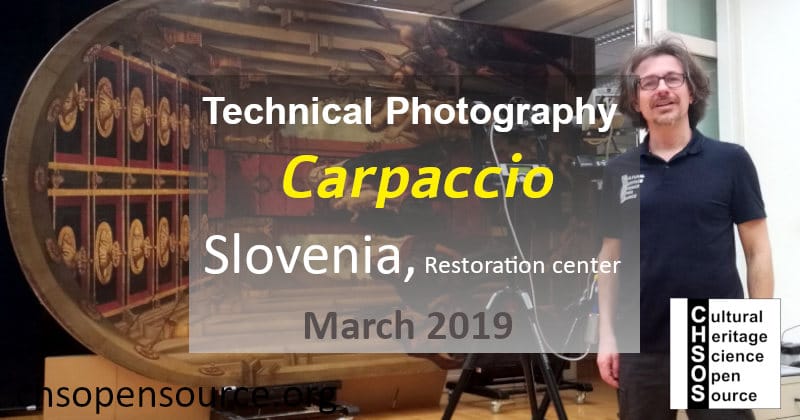
Just performed Technical Examination on a large painting by Carpaccio (1465-1526) in Slovenia for the Institute for Protection of Cultural Heritage
CHSOS was invited for a two-days technical examination service on March 25-26 in Ljubljana by Barbka Gosar
CHSOS was involved for some of the imaging and spectroscopic diagnostics methods that they planned to apply on this painting, before conservation treatment.
This was a nice occasion to review documentation of large paintings and the issues that come with the examination of such large surfaces. The painting is large 4,2 x 2,5 m.
We used our Technical photography kit including Fabrizio UV lamp, Robertina filters set, and Alice IRF lamp.
We divided the painting in 2 sections for Technical Photography examination with the head of the Madonna and the feet of Jesus as the overlapping area that should be present in all the 2 areas. This division results in each area large 2,4 m. We used a panoramic head, a full frame camera, an 85 mm lens (FOV 15 degree), distance camera – painting 3 m, and aperture f/10 (for all images methods), ISO 100. Put the TP–MSI calibration card. We took 15 images per area with 25% overlapping. Some more detailsç
VIS. Pano head time 10 sec, allows 6 sec before shooting for stabilization), exp 1 sec.
RAK. Same set up as the vis.
IR. Same set up as vis just exp 2 sec.
IRT. Same set up just exp 2.5 sec.
UVR. Same set up just exp 6 sec.
UVF ((same set up just exp 8 sec )
IRF. 35 mm lens, same set up just exp 15 sec.
IRR. 85 mm lens, same distance Nikon lens f5.6.
We also performed Infrared Reflectography and Reflectance Spectroscopy with our system Gorgias.

dav 
dav
The most exciting results came from IRT (Infrared Transmitted) which revealed the amazing underdrawing typical of Vittore Carpaccio. So exciting working with such a beautiful piece. Many thanks to the stuff of the Restoration Center of the Institute for Protection of Cultural Heritage of Slovenia for the welcoming and interest in the diagnostics methods that CHSOS promotes. It was also the occasion to meet up with long term followers of the CHSOS initiative from Slovenia. The conservation treatment is supposed to be completed
The most exciting results came from IRT (Infrared Transmitted) which revealed the amazing underdrawing typical of Vittore Carpaccio. So exciting working with such a beautiful piece. Many thanks to the stuff of the Restoration Center of the Institute for Protection of Cultural Heritage of Slovenia for the welcoming and interest in the diagnostics methods that CHSOS promotes. It was also the occasion to meet up with long term followers of the CHSOS initiative from Slovenia. The conservation treatment is supposed to be completed







